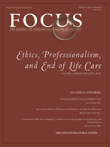This Couldn't Happen to Me: Boundary Problems and Sexual Misconduct in the Psychotherapy Relationship
Abstract
Drawing on their own consultative experience illustrated by case vignettes and with support from the professional literature, the authors discuss the perennial problematic issue of boundary violations and sexual misconduct, aiming at an audience of both experienced and novice clinicians. The authors review the difference between boundary crossings and boundary violations and stress the therapist's responsibility to maintain boundaries. Therapist risk factors for violations include the therapist's own life crises, a tendency to idealize a “special” patient or an inability to set limits, and denial about the possibility of boundary problems. Factors exacerbating patient vulnerability, such as overdependence on the therapist, seeking therapy to find an intense relationship or even “true love,” and the acceptance by childhood abuse victims of an abusive therapy relationship, are discussed. Consultation and education—for students and for clinicians at all levels of experience—and effective supervision are reviewed as approaches to boundary problems.
(Reprinted with permission from Psychiatric Services 2003; 54(4):517–522)



